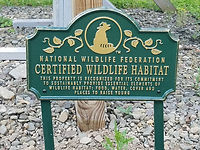
_edited.jpg)

Create Firefly-Friendly Habitat
The International Union for Conservation of Nature (IUCN) is estimating 14% of firefly species are threatened or on the verge of extinction. The most likely cause is the loss of habitat in one form or another. However, there are steps you can take to create a firefly-friendly habitat in your own backyard. The ideal firefly habitat is also hospitable to many other important species. The firefly is often referred to as an indicator or "Umbrella Species", in other words, the existence of fireflies in a habitat indicates that it is healthy and balanced. Therefore, other plants and animals will also thrive in that environment, because what's good for fireflies is probably good for everyone. Below are the critical components you can try to create or restore the ideal conditions for fireflies.


Dark
Probably the easiest and least expensive component to create is darkness. It is the first requirement for most species of fireflies and other nocturnal creatures. Simply turn off outdoor lights completely or at least minimize the intensity and exposure. Keep lighting to a minimum by shading or using timers and motion detectors. "Lights Out For Lightning Bugs!"



Cover
During the daytime, adult fireflies need cover and shade to protect them from the sun and heat of the day. Mow less often and when you do, cut at a higher mower height. Allow more areas to grow wild or plant indigenous plants that will provide cover, especially in riparian areas or adjacent to water.


Undisturbed soils
Leave the leaves! Fireflies spend the majority of their lifecycle in the larval stage, which can be up to two years. This means they live in the soil, leaf litter, and tree bark year-round. They are known to be ravenous carnivores preying on other soft-bodied invertebrates like snails, slugs, and earthworms. Leaflitter supplies several benefits to the habitat and the fireflies including cover, insulation, and nutrients for the soils. Mulching and soil preservation are best practices for gardening and fireflies.


Moisture
The fireflies prefer moist soils in which to live, and lay eggs. Provide water features and/or keep water and riparian edges as natural as possible.

Pesticide Free
Maybe it goes without saying, but for some who are striving for the perfect lawn and garden using herbicides and pesticides seems the only answer. However, pesticides are not specific to any one pest. For instance, what kills Japanese beetle grubs will also kill firefly larvae. Try to find the most organic means to control pests or learn to accept some degree of imperfection.

Get your habitat certified "Firefly-Friendly"

If you have implemented these measures to create a firefly habitat, you can get a certificate from Firefly.org or have your backyard certified by the National Wildlife Federation. Both of these organizations provide certification to raise funds for wildlife conservation.